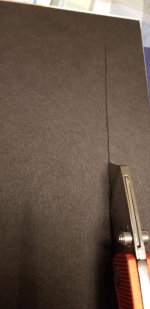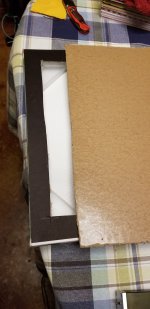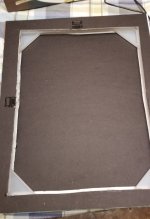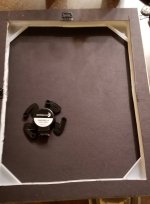That is more or less how I reasoned it out homesw............. The tricky part is how much 1,2g effects a 30g exciter. All I can do is add more to see what that does. One alternative I noticed on here is to stick them to low tack tape applied to the panel. Others use a different adhesive maybe removing Dayton's. The foam they use is very sticky stuff and not that easy to remove from anything.
REW is a bit of a problem at the moment. I need to update my OS to use it and decided to update my PC as well. Not gone well. HP have supplied me with a machine that sounds like a vacuum cleaner at times. It looks to be a design flaw to me or faulty - which I doubt.
I have used Rightmark but dated and no longer supported. Under wine on linux leaves questions and certain messages that pop up suggest it may not be happy with more recent processors. I've used it to check the performance of my USB sound card. Looks ok but........ Java based software should perform perfectly on Linux - give the right release. REW needs that. My OS comes with an open source version of java. I may need to change my distro. Various companies produce linux desktop set ups.
I need to sort out a couple of other things as well before I can do much. In hand and the PC problem is annoying.
REW is a bit of a problem at the moment. I need to update my OS to use it and decided to update my PC as well. Not gone well. HP have supplied me with a machine that sounds like a vacuum cleaner at times. It looks to be a design flaw to me or faulty - which I doubt.
I have used Rightmark but dated and no longer supported. Under wine on linux leaves questions and certain messages that pop up suggest it may not be happy with more recent processors. I've used it to check the performance of my USB sound card. Looks ok but........ Java based software should perform perfectly on Linux - give the right release. REW needs that. My OS comes with an open source version of java. I may need to change my distro. Various companies produce linux desktop set ups.
I need to sort out a couple of other things as well before I can do much. In hand and the PC problem is annoying.
Some many posts ago I described what works for me in terms of temporary fixing.Sorry there seems to be a bit of a misunderstanding. In terms of testing I don't want any help. In respect to that I want to do much the same as others. Different panel materials etc. This involves fitting exciters each time that is changed and i don't want to have to buy an exciter for each change so searched this entire thread for ideas on removing them and reusing them when attached as Dayton intend. Stuck on. Not many posts so wondered if there were any fresh ideas on reusing exciters each time a panel is changed.
My own idea is as I mentioned so will try it. It leaves a bit of a problem. What the added weight does to measured performance. I can easily add another gram and if this doesn't alter that much fine. If it does well I will have to accept that or get them off and stick them on somehow each time the panel is changed.
All for personal interest and nothing else.
Apply 50mm wide painters making tape to the panel. Make the strip long enough so you can get to the edges when the exciter is in place. Glue (or use the double sided tape already applied to the voice coil (for the first application at least)) the exciter in place. Take two strips of 20 or 25mm making tape about 200-250mm long, stick the lower end of each to the exciter body and the top to the panel, forming a V configuration hanger to support the exciter .. To stop the hanger tape fluttering while playing, carefully pinch fold each 'leg' in half along the length, this will both stiffen each leg and tension the support without preloading it too much.
When finished testing, peel off the hanger tapes, work up the edge of the tape on which the exciter is glued/stuck, and peel it away from the panel. If you're careful, the exciter may stay stuck to the tape and you can reapply it to the next panel. If not, it's a simple matter to repeat the process.
Thank you for the link Toddincabo.
@spedge : Steve, if you are still reading this thread (what I hope) => 👍
Christian
Hi AjohnLThe tricky part is how much 1,2g effects a 30g exciter.
Is 30g the weight of the complete exciter. Mine which are not really big (25mm voice coil) are around 100g if I remember... But the main point is not here : the additional weight comes upon the voice coil mass which is 1 or 2g. So the same order of magnitude than the additional mass. In the test i made : on a canvas panel, almost no effect on the bandwidth to add a mass (see #4398 and the pdf in #4386)
Have a look #5130 for the effect of a mass on a XPS panel.
My computer runs also under Linux (Manjaro distro / Arch based). Previously, I used the installer from REW site. Now it is available on the Arch repository. The 2 troubles I add in the past were to point to the right Java (don't remember how it was solved...) or to select the audio devices. But generally speaking, REW works fine under Linux. Except if you laptop is too noisy, from OS point of view you should find solutions (Ubuntu?)REW is a bit of a problem at the moment. I need to update my OS to use it and decided to update my PC as well. ...... Java based software should perform perfectly on Linux - give the right release. REW needs that. My OS comes with an open source version of java. I may need to change my distro. Various companies produce linux desktop set. In hand and the PC problem is annoying.
Christian
https://www.daytonaudio.com/product...25mm-interchangeable-hardware-mount-20w-4-ohm.... for each change so searched this entire thread for ideas on removing them and reusing them when attached as Dayton intend. Stuck on.
This is not the best solution, as the interchangeable puck seems to introduce a resonance at HF.
But that's the factory solution.
Good luck.
Thanks. A useful post. I'll keep the pdf and canvas is one of the materials I want to try. On added mas though. A single metal short M4 screw weighs more than all of the parts needed to do it with nylon. I could probably reduce that weight by making bits out of delrin but would rather not at the moment. When the exciters are in use they work against the rest of the mass of their entire body. Inertia must figure. The main body will move as well as the panel. LOL It could be argued that mass needs to be added to that as well to maintain a balance. Pass. It's one of those things that can only be tried.Is 30g the weight of the complete exciter. Mine which are not really big (25mm voice coil) are around 100g if I remember...
I'm a Suse followed by OpenSuse rather long term KDE man. Of late it's falling behind on application updates. Ubuntu seems to have a lot less of that problem. I have wondered about using Arch directly as could probably follow an installation guide. I worked in automotive electronics and software always using a windows PC and got fed up with a number of aspects about windows yonks ago so switched at home.I don't make much use of the console. Can compile etc if needed otherwise it's google to find the command line to provide the info I want.from OS point of view you should find solutions (Ubuntu?)
Yeh. I thought there may be a problem telling REW where java is. Hopefully some distro's use java's own or it's easier to switch. I have download java's entire dev kit in the past rather than just the runtime. That is bound to create some file associations.
FYI for those playing around with framed canvas, for the next few days large canvas photo prints (16"x20") are on sale at CVS for $20. I bought two and am in the process of converting them to DMLs. They do not come with heavy wood frames (it is something lighter) and have a back cardboard panel that will need to be cut off for access. The frame is pretty deep about 1.5" so there is plenty of space for the exciter.
CVS canvas photos
CVS canvas photos
OK here is what I came up with as a quick and dirty implementation. This is using the above mentioned CVS canvas prints. Basically I tried one with just the canvas and it did not sound very good, and had a nasty ring at 1500 Hz, like a not happening unacceptable level of ring.
So I cut the back off of one of them and found that the backing was not only cardboard, but had an adhesive layer. So I slipped it under the frame corners and stuck it to the back of the canvas. After playing around with pink noise and an RTA with a waterfall plot I found a spot that reasonably spread the energy across the spectrum so I stuck the exciter in place. The photos of the operation are attached.
This is the exciter I used - Dayton DAEX25Q
The result is good. Not jaw dropping hi-fi sound but good enough for two pictures I'll be hanging up in the kitchen. It definitely sounds better than I would expect for something I threw together with $15 exciters in a couple of hours tops including testing. I will be adding spines tomorrow (exciter to frame) to see what that does. Also the adhesive used on the frames/backing/canvas is not exactly 3M VHB so I may augment that as well.
The wife is happy with them. She did have a problem when I played some Swedish Death Metal using the photo of our daughter LOL. Maybe it is because our daughter is into JAPANESE Death Metal, not Swedish.
So I cut the back off of one of them and found that the backing was not only cardboard, but had an adhesive layer. So I slipped it under the frame corners and stuck it to the back of the canvas. After playing around with pink noise and an RTA with a waterfall plot I found a spot that reasonably spread the energy across the spectrum so I stuck the exciter in place. The photos of the operation are attached.
This is the exciter I used - Dayton DAEX25Q
The result is good. Not jaw dropping hi-fi sound but good enough for two pictures I'll be hanging up in the kitchen. It definitely sounds better than I would expect for something I threw together with $15 exciters in a couple of hours tops including testing. I will be adding spines tomorrow (exciter to frame) to see what that does. Also the adhesive used on the frames/backing/canvas is not exactly 3M VHB so I may augment that as well.
The wife is happy with them. She did have a problem when I played some Swedish Death Metal using the photo of our daughter LOL. Maybe it is because our daughter is into JAPANESE Death Metal, not Swedish.
Attachments
Last edited:
Dude,
The 12x16" canvas panels (6 in the pack, if I remember correctly) were something like $12 or less, if I remember correctly, at Walmart, and came as just the canvas panel stretched and stapled on a light wood frame. That is what I and spedge used, with a thin 4x6" rounded corners wood panel glued centered on the back of the canvas with pva glue (titebond). I used acrylic paint thinned 5"1 on front and back, which provided solid covering, as I didn't like the white color of the can. They will play 40Hz at a lower volume as opposed to the rest of the spectrum. I play mine at a moderate volume and they sound quite good. In fact, I just bought another pair of Dayton DAEX25HFE-4 24watt,4 ohm exciters to make a second pair.
The 12x16" canvas panels (6 in the pack, if I remember correctly) were something like $12 or less, if I remember correctly, at Walmart, and came as just the canvas panel stretched and stapled on a light wood frame. That is what I and spedge used, with a thin 4x6" rounded corners wood panel glued centered on the back of the canvas with pva glue (titebond). I used acrylic paint thinned 5"1 on front and back, which provided solid covering, as I didn't like the white color of the can. They will play 40Hz at a lower volume as opposed to the rest of the spectrum. I play mine at a moderate volume and they sound quite good. In fact, I just bought another pair of Dayton DAEX25HFE-4 24watt,4 ohm exciters to make a second pair.
You are starting a new variant of canvas panel. The one I built are as @jaxboy described except the pad which made from thin balsa boards. The canvas for painting have wood frame. The 4 members of the frame are not glued together but can move so that you can adjust the tension of the canvas thanks to small wood triangular parts.So I cut the back off of one of them and found that the backing was not only cardboard, but had an adhesive layer. So I slipped it under the frame corners and stuck it to the back of the canvas. After playing around with pink noise and an RTA with a waterfall plot I found a spot that reasonably spread the energy across the spectrum so I stuck the exciter in place. The photos of the operation are attached.
AjohnL,I did a search on here on using the same exciter on different panels.
I find that thin double sided tape works very well and is easy to use. I have "test" exciters of my favorite models that have been previously used and hence no longer have the original VHB adhesive on them. I use these for testing prototype panels of different sizes, materials boundary conditions etc. I simply cut a piece of the double sided tape, press the tape firmly to the panel, remove the release film, and press the exciter to the other side of the tape. When I'm done with the test, I just pry the exciter off the tape with a putty knife, by sliding the tip of the blade between the tape and the foot of the exciter and gently twisting the blade.
Usually I just leave the tape in place (at least for a while) in case I want to put the exciter back in the same location again later. Usually the tape itself is good for several uses before it loses its tack.
The image below shows a typical prototype of mine. Notice all the little squares (and strips) of double sided tape all over the back! My test exciter apparently has been tested in at least about 20 different places on that panel alone. And that particular exciter has been used literally hundreds of time on different panels.
The putty knife I use to remove exciter is the blue handled tool on the bottom left.
I suspect there are many types of double sided tape that would work. The two I use are 3M 401M and 3M 9589, both are 2" wide. These are kind of expensive, it seems. I inherited mine, so got them free. These are much less expensive but may work just as as well:
https://www.uline.com/Product/Detai...Tape/Double-Sided-Masking-Tape-1-1-2-x-36-yds
https://www.uline.com/Product/Detail/S-15718/Double-Sided-Tape/Double-Sided-Film-Tape-2-x-60-yds
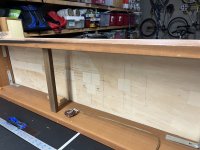
Thanks for the info. I like the wooden frame part. The frames on these are plastic, which is not as stiff but may damp more. These prints are 16"x20" BTW and I can hear some decent bass extension below 100 Hz. I don't have a good f3 number yet.Dude,
The 12x16" canvas panels (6 in the pack, if I remember correctly) were something like $12 or less, if I remember correctly, at Walmart, and came as just the canvas panel stretched and stapled on a light wood frame. That is what I and spedge used, with a thin 4x6" rounded corners wood panel glued centered on the back of the canvas with pva glue (titebond). I used acrylic paint thinned 5"1 on front and back, which provided solid covering, as I didn't like the white color of the can. They will play 40Hz at a lower volume as opposed to the rest of the spectrum. I play mine at a moderate volume and they sound quite good. In fact, I just bought another pair of Dayton DAEX25HFE-4 24watt,4 ohm exciters to make a second pair.
Titebond is the adhesive I was considering if I reattached the cardboard to the canvas. However I let them sit overnight with weight clamping and the bond feels pretty good.
I saw your posts on your canvas prints and your wood panels. I was headed in that direction but decided to give the packing a quick try in the name of experimentation. Someone else here showed an adhesive-coated, corrugated-cardboard, full backing on theirs so this is similar to that albeit much more compliant. To my ear it sounds as if the bandwidth frequency was shifted downward as a result but a little EQ brought out the response above 10kHz.
Last edited:
@Veleric thanks for the tape tip. I usually have some 3M automotive trim tape around for whatever and may use that for the spine. It is strong enough for this and is a foam tape. I am going to finish these up, hang them, and call it good (enough) so I can move onto the much larger DML panels I want to build for the shop. I plan to experiment with those more than these.
That is a huge panel by the way! Very cool.
That is a huge panel by the way! Very cool.
I posted several times about my current preference for using panels that are relatively high aspect ratio (more than 3:1) and mounted to a rigid frame with foam tape around most or all of the perimeter. Below is the result of an experiment where I started with a 48" x 24" (2:1 aspect ratio) panel and then cut it down in steps (widthwise) to 48" x 14", and measuring the frequency response with REW at each width.
The panel is a 4.6 mm thick, 5 ply "birch" plywood from Leow's. I put "birch" in quotes because this plywood has only thin birch skins, with the cores plies unspecified but most likely poplar. The panel is attached to a sturdy frame similar to that shown my most recent post above. The panel was attached to the frame with 1/2" wide 3M 411 mounting tape around the perimeter (except about an inch or two in the corners). The exciter position varied slightly. For each aspect ratio I tried several different locations and selected the best/flattest one for the plot below.
Anyway, here are the results:
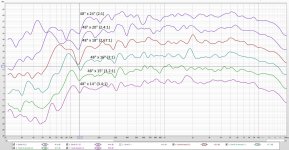
My focus is on the low frequency range, say 40 Hz to about 160 Hz, where most of the differences are.
Not surprisingly, the largest (widest) panel (2:1) has the lowest fundamental frequency, and hence has significant output at lower frequency than any other aspect ratio, down to nearly 40 Hz. However, between 40 Hz and 160 Hz, the output is weak. But as the panel gets narrower and narrower, the region of weak SPL output between the first peak and consistently strong SPL gets smaller and smaller. And finally, at the 3.4:1 aspect ratio, there is only a small dip at about 125 Hz, but otherwise reasonalby consistent SPL from 100 Hz up.
When I have used panels of even smaller aspect ratio than 2:1, I typically see similar "lumpy" low frequency response, like the 2:1 aspect ratio above. So far, the best way I have found to reduce this "lumpiness" is with high aspect ratio panels mounted as I described here.
Eric
The panel is a 4.6 mm thick, 5 ply "birch" plywood from Leow's. I put "birch" in quotes because this plywood has only thin birch skins, with the cores plies unspecified but most likely poplar. The panel is attached to a sturdy frame similar to that shown my most recent post above. The panel was attached to the frame with 1/2" wide 3M 411 mounting tape around the perimeter (except about an inch or two in the corners). The exciter position varied slightly. For each aspect ratio I tried several different locations and selected the best/flattest one for the plot below.
Anyway, here are the results:

My focus is on the low frequency range, say 40 Hz to about 160 Hz, where most of the differences are.
Not surprisingly, the largest (widest) panel (2:1) has the lowest fundamental frequency, and hence has significant output at lower frequency than any other aspect ratio, down to nearly 40 Hz. However, between 40 Hz and 160 Hz, the output is weak. But as the panel gets narrower and narrower, the region of weak SPL output between the first peak and consistently strong SPL gets smaller and smaller. And finally, at the 3.4:1 aspect ratio, there is only a small dip at about 125 Hz, but otherwise reasonalby consistent SPL from 100 Hz up.
When I have used panels of even smaller aspect ratio than 2:1, I typically see similar "lumpy" low frequency response, like the 2:1 aspect ratio above. So far, the best way I have found to reduce this "lumpiness" is with high aspect ratio panels mounted as I described here.
Eric
That I like as it's the foam types that give most griefThe two I use are 3M 401M and 3M 9589
Peeling off the release film, I expect is what causes that grief?!That I like as it's the foam types that give most grief
Eric
Eric that test and the resulting graph is great thanks. I will say I was considering the same test and would have most likely done it very much in the same manner that you did. A few observations:
Based on all of your modeling and testing to date, would you think this trend would extrapolate (within reason) to different ply thicknesses and boundary conditions?
- Intuitively your conclusion of aspect ratio vs 'lumpiness' makes sense to me from a physical standpoint. The farther apart the length vs width is, the less likely they will have complimentary modes. I am speaking very loosely.
- Regardless of aspect ratio, response in general really gets messy below 100 Hz or so which seems to be a general trend from everything I have read here so far.
- The higher aspect ratios have a response below 120 Hz that would be more manageable from a EQ/DSP standpoint.
- There is a significant 7 dB peak that comes and goes at 2kHz as the aspect ratio increases. That is tangentially interesting.
Based on all of your modeling and testing to date, would you think this trend would extrapolate (within reason) to different ply thicknesses and boundary conditions?
Hello EricI posted several times about my current preference for using panels that are relatively high aspect ratio (more than 3:1) and mounted to a rigid frame with foam tape around most or all of the perimeter. Below is the result of an experiment where I started with a 48" x 24" (2:1 aspect ratio) panel and then cut it down in steps (widthwise) to 48" x 14", and measuring the frequency response with REW at each width.
The panel is a 4.6 mm thick, 5 ply "birch" plywood from Leow's. I put "birch" in quotes because this plywood has only thin birch skins, with the cores plies unspecified but most likely poplar. The panel is attached to a sturdy frame similar to that shown my most recent post above. The panel was attached to the frame with 1/2" wide 3M 411 mounting tape around the perimeter (except about an inch or two in the corners). The exciter position varied slightly. For each aspect ratio I tried several different locations and selected the best/flattest one for the plot below.
Anyway, here are the results:
View attachment 1162368
My focus is on the low frequency range, say 40 Hz to about 160 Hz, where most of the differences are.
Not surprisingly, the largest (widest) panel (2:1) has the lowest fundamental frequency, and hence has significant output at lower frequency than any other aspect ratio, down to nearly 40 Hz. However, between 40 Hz and 160 Hz, the output is weak. But as the panel gets narrower and narrower, the region of weak SPL output between the first peak and consistently strong SPL gets smaller and smaller. And finally, at the 3.4:1 aspect ratio, there is only a small dip at about 125 Hz, but otherwise reasonalby consistent SPL from 100 Hz up.
When I have used panels of even smaller aspect ratio than 2:1, I typically see similar "lumpy" low frequency response, like the 2:1 aspect ratio above. So far, the best way I have found to reduce this "lumpiness" is with high aspect ratio panels mounted as I described here.
Eric
Very interesting test.
What about the Young modulus of this plywood in the 2 directions?
Christian
Pardon me if it has already been brought up, but as far as determining the effective modulus, one can use a simple three-point bending test to determine modulus within a reasonable amount of error. This could also be done with samples cut in different directions to determine isotropy or anisotropy. I'll try to do this when I start building the next larger DML. That will also be ply based (what Eric has above).
Speaking of which Eric, another thanks for that test, since it casts more light on panel size. That bass dropoff is brutal though at >20 dB/octave (between 50 and 100 Hz). Ouch.
Speaking of which Eric, another thanks for that test, since it casts more light on panel size. That bass dropoff is brutal though at >20 dB/octave (between 50 and 100 Hz). Ouch.
Circling back briefly to post #9929 I removed the rest of the backing from the frame and found this. In retrospect it would be easier to remove the backing and THEN trim it down to size for attaching to the canvas. Also, the frame on the front side supports the canvas in a very simply supported manner; there is a thin protrusion around the outer edge of the frame that holds the canvas away from the main body of the frame.

- Home
- Loudspeakers
- Full Range
- A Study of DMLs as a Full Range Speaker

